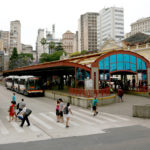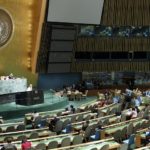Posts in the 'Climate Resilience' category
Rapid urbanization, economic growth and climate change are putting increasing pressure on urban communities around the world. While strong physical structures are important, social relationships play a key role in determining urban communities’ resilience during adverse weather events. Community resilience ...

In addition to counting people, cars and kilometers of infrastructure, cities today are counting trees. Urban forests are another tool to combat climate change and increase quality of life in cities. Furthermore, concrete urban jungles lack a connection to nature, which directly ...

WRI Ross Center for Sustainable Cities is reporting on Habitat III from Quito, Ecuador. Follow our daily coverage on TheCityFix. Habitat III, the third United Nations Conference on Housing and Sustainable Urban Development, officially began on Monday, October 17th in Quito. ...

As home to more than half the world’s population, cities are some of the places most vulnerable to the impacts of a warmer world. Yet in many ways, they’re still not equipped to deal with the challenges climate change presents. ...

Cities are at the forefront of combatting climate change. Many cities and municipal governments and agencies were party to the Paris Agreement reached at COP21 in December, and many have committed to ambitious greenhouse gas reduction goals and meaningful climate ...

From February 24 – 26, 2016 African ministers and stakeholder representatives from numerous civil society organizations gathered in Abuja, Nigeria to discuss African priorities for Habitat III, the U. N.’s 20-year urbanization conference that takes place in October. At the end ...

TheCityFix is covering cities at COP21. Urban areas account for a large share of greenhouse gas emissions but are also tremendous agents of innovation to address climate change. Read our full coverage of the Paris Climate Conference as it relates to cities, buildings, and mobility. The world ...

TheCityFix is covering cities at COP21. Urban areas account for a large share of greenhouse gas emissions but are also tremendous agents of innovation to address climate change. Read our full coverage of the Paris Climate Conference as it relates to ...

Over the last century, India’s landscape has urbanized considerably: the urban population has grown 14 times since 1901, and by 2050 up to 54 percent of India’s population will be urban (ACCCRN). Much of this urban growth is occurring in ...

This weekend, from September 25 – 27, more than 150 world leaders will convene in New York City for the United Nations Sustainable Development Summit to develop the new sustainable development goals (SDGs). This agreement will serve as the foundation ...

How do we make cities work for people? As a WRI Helms Fellow on Urban Governance and Sustainable Cities, Maria Antonia Tigre was tasked with answering this question. Through From ideas to implementation: making sustainable cities through governance here on ...

If global temperatures rise by 2º Celsius, New York City (NYC) could lose up to 1.8 million of its residents. However, unlike other cities who are simply working to mitigate climate change, NYC is working to adapt its cityscape to ...

The World Summit Climate & Territories (#WSCT) gathered 800 local decision makers in Lyon, France, July 1-2, 2015. In the lead up to COP21 (the 21st Conference of the Parties)—one of the most important climate meetings of the year—mayors and ...

Climate-smart actions—such as investing in public transport and building efficiency—could generate $17 trillion dollars in net savings for cities by 2050 and cut annual greenhouse gas emissions by more than the annual emissions of Japan and Russia combined. Furthermore, with ...

Given our increasingly complex and dynamic world, cities need to be continuously innovating in order to solve pressing social and environmental problems. Many cities worldwide are growing rapidly, and by 2050 it is estimated that 70 per cent of the world’s ...























